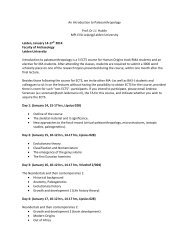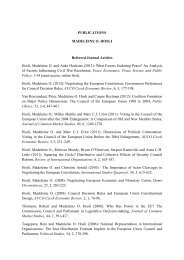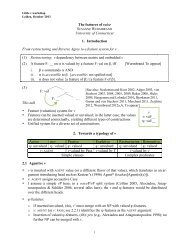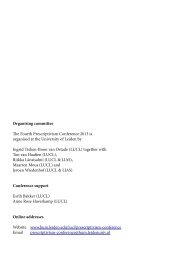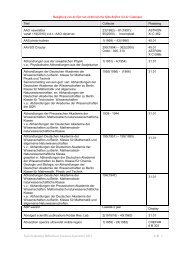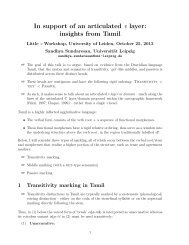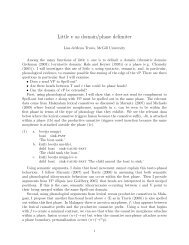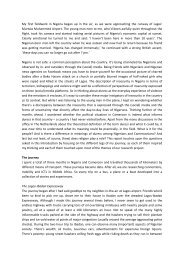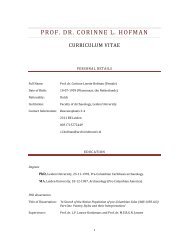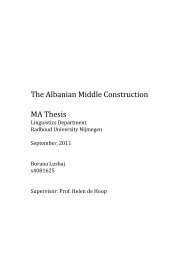Institute for History Annual Report 2010 - O - Universiteit Leiden
Institute for History Annual Report 2010 - O - Universiteit Leiden
Institute for History Annual Report 2010 - O - Universiteit Leiden
Create successful ePaper yourself
Turn your PDF publications into a flip-book with our unique Google optimized e-Paper software.
continued existence of countless small farms<br />
during the last two centuries BC (cf. below).<br />
Building on these non-literary data a vigorous<br />
school of ‘optimists’ has argued that the idea of<br />
population decline is a figment of the literary<br />
tradition. The principal weakness of this position<br />
is that it makes it difficult to find a convincing<br />
explanation <strong>for</strong> the Gracchan land re<strong>for</strong>ms. The<br />
solution proposed by some optimists is that the<br />
rationale of these re<strong>for</strong>ms was purely social rather<br />
than demographic.<br />
The aim of this project is to test the hypothesis<br />
that, contrary to all existing reconstructions, the<br />
second century BC witnessed a rapid expansion<br />
not only of the Roman citizenry but of the Latin<br />
and other Italian allies as well. A major advantage<br />
of this unorthodox approach is that it may provide<br />
us with a new and convincing background to the<br />
Sempronian law of 133 BC. The guiding idea is<br />
that since the obligation to serve in the army<br />
rested only on those owning a certain amount of<br />
land, population growth had the paradoxical effect<br />
of diminishing the number of potential recruits.<br />
Gaius Marius’ decision to abandon the property<br />
requirement <strong>for</strong> military service, taken in 107 BC,<br />
can be seen as the ultimate solution to this<br />
problem. The textual evidence pertaining to<br />
demographic developments during the second<br />
century BC is surprisingly abundant. Its principal<br />
components are the census figures reported by<br />
Livy and other sources, numerous mobilization<br />
and casualty figures and some valuable surveys of<br />
the number of recruits available in particular<br />
years. The aim is to study these data with the help<br />
<strong>Institute</strong> <strong>for</strong> <strong>History</strong><br />
17<br />
of demographic models, including comparative<br />
evidence concerning plausible rates of population<br />
growth.<br />
The Role of State-Owned Land in the<br />
Roman Economy (This PhD-project was<br />
finalized in 2009)<br />
According to the literary sources the illegal occupation<br />
of large tracts of public land by the rich led<br />
to massive rural impoverishment. Since Tiberius<br />
Gracchus’ proposal concerned the redistribution of<br />
ager publicus, there seems little reason to challenge<br />
this picture. Un<strong>for</strong>tunately, there are serious<br />
difficulties. Since holdings of public land were not<br />
counted as part of the private property required<br />
<strong>for</strong> military service, it is not immediately apparent<br />
how the take-over of public land by the wealthy<br />
elite could have helped to create a shortage of<br />
potential recruits. It is true that a very substantial<br />
part of the Italian ager publicus was eventually<br />
turned into the private property of those already<br />
holding the land. This, however, seems to have<br />
happened only after the Gracchi had violently<br />
been removed from the scene.<br />
Starting from the idea of population growth a new<br />
interpretation comes to mind. Is it perhaps the case<br />
that the importance of communal land in early<br />
republican history is linked with low population<br />
densities? And cannot the ultimate privatization of<br />
much of the <strong>for</strong>mer ager publicus be seen as a<br />
response to an increase in population (as well as to<br />
the emergence of a more commercialized type of<br />
agricultural production that was itself linked to<br />
population growth and urbanization). In exploring




